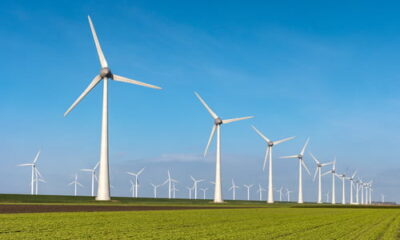

Energy
Pressure on energy bills rises as national renewable power policy gets a makeover
Pressure on energy bills continued to increase as the coalition reshapes the national renewable power policy with two announcements.
Underlying policy moves in the renewables sector is the implicit understanding that the era of cheap energy is well and truly ended. The costs of producing our power will continue to rise painfully over the next 20 years as we import more gas and build nuclear power stations while subsidising renewable sources, as we phase out ‘dirty’ generators like coal.
The government first trumpeted the decision to give the green light to eight major renewable electricity projects. Over the next six years, the projects will attract up to £12 billion of private sector investment, supporting as many as 8,500 jobs.
Then the Conservative party announced on Thursday that, with a parliamentary majority, it will not only end the subsidy for onshore wind farms, but also give local councils powers to stop more being built. The coalition is split on this, with Conservative energy minister Michael Fallon saying that the country has enough onshore wind farms while Ed Davey, the Lib Dem energy secretary, predicting that the move would lead to higher energy bills.
Contrarily, Davey also predicted that whole package on energy reforms would at some point lead to lower consumer energy bills. His prediction did not go into detail about how this will be achieved and the only conclusion, given the energy arithmetic, is that we will all have to reduce our consumption of power substantially and in a sustainable way.
The combined projects are expected to add 2% to an average household electricity bill by 2020, or £11 per household.
Whatever the cultural, commercial and aesthetic drivers behind the two decisions, it is accepted that power from renewable sources is more expensive, and always will be so. But investment in renewables is absolutely essential if the UK is to meet short and longer-term carbon emissions reduction targets.
We are slowly getting used to the idea of expensive utilities and it’s an uncomfortable time for all. On the positive side, the government backing for the eight renewable electricity projects should contribute around 15 terrawatt hours (TWh) or 14% of the renewable electricity target for 2020. They will also reduce emissions by 10 million tonnes (MtCO2) a year compared to fossil fuel power generation.
The mix of offshore wind farms, coal to biomass conversions and a dedicated biomass plant with combined heat and power could add a further 4.5 gigawatts (GW) of low-carbon electricity to the country’s energy mix, around 4% of capacity, generating enough clean electricity to power over 3 million homes.
The projects have been offered under contracts for difference (CfD), which form part of Government’s electricity market reform programme, supported by the new legislative framework introduced through the Energy Act 2013.
Under CfDs, generators and developers receive a fixed strike price for the electricity they produce for 15 years. These contracts give investors the confidence to pay the up-front costs of major new infrastructure projects but clearly add upward pressure on what the consumer must pay.
While there are serious concerns over the Drax biomass element, the overall scope and vision of the renewables package is welcome, if more than a little overdue. In fact, there were 57 applications for renewable project support by way of CfDs – but the government’s coffers could not accommodate them all.
However, as Davey says, “These contracts for major renewable electricity projects mark a new stage in Britain’s green energy investment boom. By themselves they will bring green jobs and growth across the UK, but they are a significant part of our efforts to give Britain cleaner and more secure energy.”
Time will tell whether the electricity market reform programme will build the world’s first low-carbon electricity market and attract the many billions of pounds needed for energy production but the goal of reducing costs of ‘clean power’ must be viewed as a very long-term target.
There has been significant growth in renewable electricity sector with the renewables’ share of total electricity generation more than doubling since 2010 but obviously from a very low base. The coalition believes that the EMR will deliver over 30% renewable electricity by 2020.
The next step is in May, when the contracts will come into legal force. The next step for all of us is to seriously examine our consumption of energy and water. Even without serious government support for necessary reductions in power use, the imperative for action is crystal clear now.
Mark Sait is managing director of SaveMoneyCutCarbon.
Photo: Attilio Lombardo via Freeimages
Further reading:
Co-operative announces 2.4% energy bill increase
Rising energy bills prompt David Cameron to announce green tax review
Budget 2014: government must stop spiralling energy costs, says UKGBC
Ed Miliband’s pledge to freeze energy costs sparks intense debate


 Environment10 months ago
Environment10 months agoAre Polymer Banknotes: an Eco-Friendly Trend or a Groundswell?

 Environment12 months ago
Environment12 months agoEco-Friendly Home Improvements: Top 7 Upgrades for 2025

 Features9 months ago
Features9 months agoEco-Friendly Cryptocurrencies: Sustainable Investment Choices

 Features10 months ago
Features10 months agoEco-Friendly Crypto Traders Must Find the Right Exchange





























